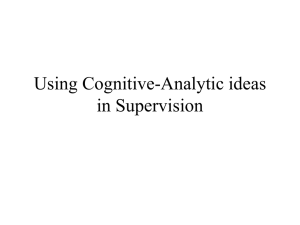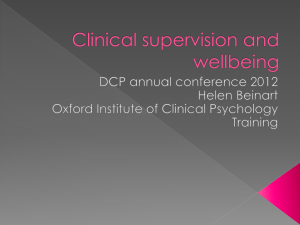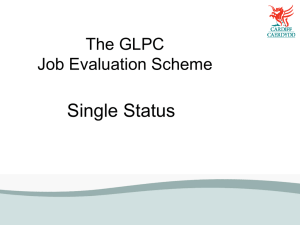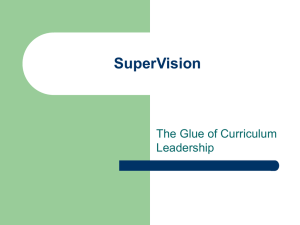Tips for supervising activists
advertisement
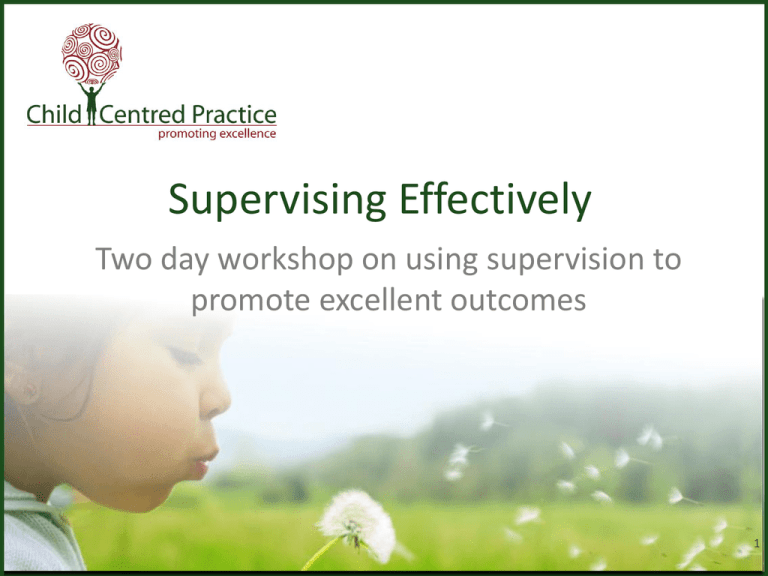
Supervising Effectively Two day workshop on using supervision to promote excellent outcomes 1 Day One Understanding supervision within the context of your organisation and yourself The four functions of Supervision • • • • Accountability Development Support Mediation Supervision is….. • Supervision is a process by which one worker is given responsibility by the organisation to work with another worker in order to meet certain organisational professional and personal objectives. These objectives or functions are: – – – – Competent accountable performance/practice Continuing professional development Personal support Engaging the individual with the organisation Adapted form Harries(1987) Richards & Payne (1990) and Butterworth and Faugier (1994) Supervision is….. • Effectively managing and supervising staff to support effective practice and good conduct and supporting staff to address deficiencies in their performance (General Social Care Council handbook) Effective support and supervision • Working to ensure children are protected from harm requires sound professional judgements to be made. It is demanding work that can be distressing and stressful. • All of those involved should have access to advice and support from, for example, peers, managers, named and designated professionals. Those providing supervision should be trained in supervision skills and have an up to date knowledge of the legislation, policy and research relevant to safeguarding and promoting the welfare of children. 4.43 For many practitioners involved in day-to-day work with children and families: • effective supervision is important to promote good standards of practice and to supporting individual staff members. The arrangements for how supervision is organised and delivered will vary from agency to agency but there are some key essential elements. It should: – help to ensure that practice is soundly based and consistent with LSCB and organisational procedures; – ensure that practitioners fully understand their roles, responsibilities and the scope of their professional discretion and authority; and – help identify the training and development needs of practitioners, so that each has the skills to provide an effective service. 4.44 Good quality supervision can help to: • avoid drift; • keep a focus on the child; • maintain a degree of objectivity and challenge fixed views; • test and assess the evidence base for assessment and decisions; and • address the emotional impact of work. 4.45 It is particularly important that social workers have appropriate supervision: • The recent report ‘Building a safe, confident future: the final report of the Social Work TaskForce’ emphasised that supervision is a critical aspect of the support that employers should provide to social workers. It identified three specific functions of the supervision which must be in place to support effective practice: 1. Line management; 2. professional (or case) supervision; 3. and continuing professional development. Supervision enables • Both supervisor and supervisee to reflect on scrutinise and evaluate the work carried out, assessing the strengths and weaknesses of the practitioner and providing coaching development and pastoral support. • Supervisors should be available to practitioners as an important source of advice and expertise and may be required to endorse judgments at certain key points in time. • Supervisors should also record key decisions within the child’s case records. 4.47 Supervision will be both educative and supportive • It will facilitate the supervisee to explore their feelings about the work and the family. • Effective safeguarding supervision needs to be regular and provide continuity, so that the relationship between supervisor and supervisee develops. • Each session should include agreeing the agenda, reviewing actions from previous supervision, listening, exploring and reflecting, agreeing actions and reviewing the supervision process itself. Range of settings supervision can take place • • • • • Formal Planned Ad hoc Informal Telephone The most important tool Stages of professional development • As a supervisor you will have preferences as to which stages you find easier or harder to address. • Supervisors have different tolerances across these stages. • In times of pressure or in a crisis a worker could revert to an earlier stage or level • Clear supervision contracts support supervisors to meet the needs of the supervisee at any stage of their development. Stages of professional development • what stage is your staff at in their professional development? • How do you take this into account in supervision? • What stage are you at as a supervisor in your development? Learning Styles Activists • Tend to involve themselves fully in the here and now experience, tend to be enthusiastic, gregarious, and open minded – “I will try anything once”. • They learn by doing. They act first and consider afterwards, but are prone to getting bored once the activity stops. They are less interested in looking at what they have learnt via reflecting, than on going on to the next experience. Learning Styles Tips for supervising activists • Ensure activists consider other people’s feelings, different perceptions, rationale for action, theory, research and that they plan carefully before acting. • At the same time value their energy and enthusiasm. Learning Styles Reflectors • Reflectors prefer to stand back, observe, collect data, and consider all angles –past and present- before acting. This can result in over cautiousness, and delay. They are more likely to take a back seat at first, listening to others before contributing. Reflectors pay close attention to the emotional content of the situation. Learning Styles Tips for supervising reflectors • Value and listen carefully to their observations, especially about feelings. However at the same time ensure that the reflectors do not avoid action, participation, or responsibility and that they move ahead with plans and tasks. Learning Styles Theorists • Adapt, analyse and integrate observations into complex but logical theories, thinking things through in a systematic way. They like things to be ‘right’ and focus on underlying principles, models, asking whether things are logical, or how does this fit with that? As a result they can be detached, objective and cautious about anything subjective, emotional or generated from lateral and creative thinking. Learning Styles Tips for supervising Theorists • Value and utilise the analytical skills that theorists bring. However ensure that they are clear about the role, responsibility and accountability and that they fulfil their teamwork role properly. • Theorist also need to translate their analysis into practical actions and commitments. Learning Styles Pragmatists • Are keen to try things out to see if they work in practice, wanting to experiment with new ideas. They can act quickly and confidently, but can be impatient with theorising and reflecting. Learning is about solving problems, therefore if it works it’s good. Learning Styles Tips for supervising pragmatists • They may contribute many good solutions especially when agencies and staff are under pressure. Beware, however, of allowing them to cut too many corners, thereby minimising or avoiding a proper consideration of facts, feelings, responsibilities, or real dilemmas. Styles can be changed • These styles are not cast in stone. • “Intelligence and ability are not fixed and general but variable and particular” Brotherton (1991) • How a person performs and their ability to learn is highly influenced by the context and the security of the learning environment. • Learning styles can be deliberately modified or improved so that, for example, an activist can practise ‘reflective’ skills by spending time observing rather than doing. Key messages • Supervisors and supervisees are powerfully influenced by their experiences of supervision • Supervisors need to reflect on what shapes their approach to supervision • Careful sharing of the workers supervision history provides a strong foundation for the supervisory relationship • The supervisee’s stage of development has to be taken into account in planning the most appropriate response Key messages • Experienced staff are more likely to miss out on supervision than newer staff • Individuals have a preferred learning style which needs to be acknowledged • Organisational culture may have a constraining effect on maximising benefits of different styles. The Experience matrix • Here and Now factors – what’s going on right now in supervision • Way back when – factors from the past – professional, cultural or personal • Out there now – current organisational or personal factors • Up ahead – factors relating to actual anticipated or imagined changes Taking a supervision history – potential benefits • Identifying positive motivation for supervision • Identifying significant gaps in training and confidence • Being alerted to possible blocks for the supervisee, particularly around issues of power, race, gender etc • Unpicking problems in the supervisory relationship • Building supervisee commitment towards supervision • Identifying consultancy need for the worker • Understanding the significant professional influences and experiences that shape the workers values, motivation and style. Effective supervision contracts Effective contracts have three elements: 1. Administrative: frequency, location, recording 2. Professional: purposes, focus, principles, accountabilities 3. Psychological: motivation, commitment, ownership, investment Benefits of a written contract • • • • • • • • • Reflects the seriousness of the activity Positive modelling of partnership behaviour Responsibilities and roles of both parties clear Clarity about authority and accountability Basis for reviewing and developing supervisory relationship Benchmark so supervision quality can be audited by agency Demonstrates quality of supervision offered and accepted Demonstrates use of supervision for on going development Agency can demonstrate to service users quality of supervision When negotiating contracts - Mandate • On what authority is this supervision based? What is negotiable? What responsibilities does each person have? What are the boundaries around confidentiality? What records are maintained and where are they kept? Who sees them? When negotiating contracts - Engagement Where a staff person is reluctant to enter a contract consider: • Acknowledging skills and contribution made by the worker • How the power differential between the supervisor and supervisee might be seen • Clarify perception of roles and accountability • Clarify the organisational requirements to engage purposefully in supervision. • Explore perception of supervision and seek to clarify what is agreed, unclear or disputed. • Supervisor to be aware of own feelings of frustration and anger Acknowledging ambivalence • These are often triggered by strong emotional responses to situations such as: • Personal impact of case causing sadness, despair confusion or fear. • Over identification with certain users or situations • Moral disgust, repulsion, intolerance at users situation or behaviour • Frustration of demoralisation at the lack of time or resources • Mismatch between the positive expectations of the job and the realities of it. • Resonance of current supervisory experience with previous negative experiences – ‘here I go again’. Four Irrational beliefs • I must be competent • I must be in control • I must be consistent • I must be comfortable Identified by Claxton(1988) these beliefs are particularly strong amongst the helping profession and amplified by ‘macho’ organisational cultures. The best contract is: • Arrived at through negotiation • Addresses issues and how they will be managed • Co-signed and dated • Copied for both supervisor and supervisee • Reviewed at least annually Day Two Supervision in a turbulent world Taken from Tony Morrison Supervision Training 2001 Brickman’s supervisory continuum • Pathologising – the individual is wholly responsible for all actions • Controlling – the individual needs direction on each task and tight monitoring • Expertise model – the individual carries out the directions of the expert and does not share responsibility • Empowering – promoting competence is a shared responsibility Competence Matrix Conscious competence Conscious incompetence • What I know I know and can do • Clear transferable skills • Can be explained to others Firm ground Zone • Areas of openly acknowledged gaps or weaknesses Challenge Zone Unconscious competence Unconscious incompetence • What I know or can do without being conscious of how I know it • Hard to explain to others • May be lost in conditions of turbulence or disruption Development Zone • Things which I am unaware I don’t know • Others may see these gaps or weaknesses but I do not • Roots of performance problems Danger Zone Kolb’s experiential learning cycle The functional learning environment • This sits in the middle of the Kolb cycle. • For it to operate effectively, it is necessary to create a positive organisational culture that will support effective supervision. • • • • • • • • • A functional learning environment requires: Clear agency values and goals High quality leadership Strategic planning and reviewing systems Policies, procedures and standards Clear thresholds and eligibility levels for service A robust performance management framework An effective staff development function Structures for interagency working Feedback from staff and service users. Experiencing • Learning is triggered by experience – a problem to be solved; a situation that is unfamiliar; or a need that must be satisfied. • May be intellectual, emotional physical demands or needs • Cycle is triggered by the worker experiencing a problem Reflecting • Often by processing feelings, a richer layer of observations is revealed. • Reflection explores feelings, patterns and connections arising from the experience. • It promotes the skill to recognise common elements in different situations by reference to the extensive memory bank of cases and experiences which the worker has built up over time, is crucial. Reflecting • Acknowledges and helps process the strong emotional and moral responses that are generated by the social work task. • It is important to understand what feelings belong to the situation and which to the worker Analysis • Reflection needs to lead to analysis • Lessons learnt from one situation can be applied to others • Tests hypothesis/theories against research and evidence • Helps safeguard anti discriminatory practice Action planning • Translate the analysis into planning and service delivery • Analysis and learning tested out in action • Examining the possible outcomes of actions allow for contingency planning and outcome focused planning Reflective Supervisory Cycle Negative Supervision Cycle The blocked cycle • • • • Stuck in experience Stuck in active experimentation Stuck in reflection Stuck in analysing Thank You Jo Fox Child-Centred Practice Ltd jfox@childcentredpractice.co.uk www.childcentredpractice.co.uk Again our thanks to Tony Morrison for the use of materials from his book Staff Supervision in social Care, Pavilion Publishing, 2001


